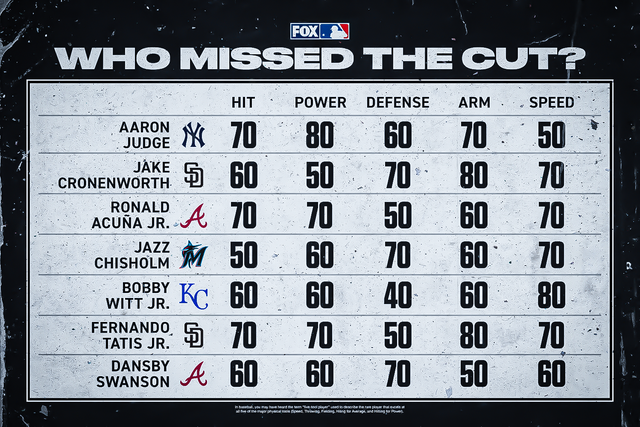
Mike Trout, Mookie Betts, Julio Rodríguez: Grading MLB’s five-tool players
By Jake Mintz
FOX Sports MLB Writer
"Five-tool player."
It's a term uttered hundreds, if not thousands, of times on baseball broadcasts, podcasts and pre- and postgame shows in any given season. It’s typically used to refer to any position player who is more than a hulking, one-dimensional slugger or a player who consistently showcases an impressive level of speed and hitting ability.
But in truth, that’s a pretty oversimplified version of the term. For professional scouts and baseball evaluators, that term "five-tool player" is hallowed ground, a rare honor bestowed upon only the true unicorns of the sport.
So what does "five-tool player" actually mean? And how many five-tool players are in the big leagues right now? Let’s hop right into it.
MLB's five-tool players
The origins of "five-tool player"
Instead of giving players a letter grade such as an A+ or C- at a particular skill, scouts grade on something called the 20-to-80 scale. It’s a bit cockamamie, but at the very least, it comes from a scientific place. The idea is that 50 is average, and every 10 points above or below that represents a standard deviation from the average — three deviations above the average and three below.
- 20 is horrible
- 30 is poor
- 40 is below average
- 50 is average
- 60 is plus
- 70 is plus-plus
- 80 is elite
Some teams and scouts will use 45 and 55, some will even use 35 and 65, but that basic 20 to 80 scale is vital in understanding (1) how pro baseball folks think about players and (2) the origins of "five-tool player."
Scouts use that grading system to score position players on the five main tools, which are:
1. Hitting for average (batting average)
2. Hitting for power (slugging/home runs)
3. Defense (eye test/defensive metrics, but those can be inconsistent)
4. Speed (sprint speed)
5. Throwing arm (eye test/velocity tracking from Statcast)
(Pitchers have their own grading system, but we’re going to gloss over that here for the purposes of this discussion.)
Each of those five tools gets a grade from 20 to 80, and for a player to be a true five-tool player in the eyes of most professional evaluators, he needs to be at least plus (60 or above) in all five categories. By using a combination of traditional stats (batting average and slugging percentage over a multiyear span) and modern motion tracking data from Statcast (sprint speed, arm strength), we can determine who the real five-tool players in the bigs are.
A note on Shohei Ohtani
Ohtani quite literally breaks the scale. He’s probably a 60 hitter with 80 power, an 80 arm and 70 speed. But we can’t put a number on his defense because he has barely played outfield in the big leagues. As a pitcher, he’s borderline elite, but that’s a different thing.
So yeah, call Ohtani a five-tool player if you want, but he’s honestly more like a six-tool player — or a superhero. Again, this dude just breaks convention.
Here are the players on my list:

Seasons change, tides rise and fall, life ebbs and flows, yet Mike Trout remains the greatest baseball player on planet earth. While that has been the case for almost a decade now, Trout hasn’t always been a true five-tool player.
For the first six or seven years of his MLB career, the Millville Meteor had a subpar throwing arm from the outfield. It wasn’t a fettuccine noodle or anything, but it was notably not elite, and for a player who was outstanding at everything else on a diamond, that stood out.
But before the 2019 season, Trout went to work over the winter on improving his throwing. And because he’s an athletic freak, now he has a plus arm to go with the rest of his overcrowded toolshed.

He’s on the injured list right now with a cracked rib, but when Mookie Betts is healthy, his whole skill set is cracked. Mookie is a generationally rare, well-rounded ballplayer. There’s nothing on the diamond he cannot do.
Betts has consistently posted batting averages above .265 for his whole career and is one of, if not the, best corner outfield defenders in the sport, in part because of his laser-beam right arm and his phenomenal foot speed. His power is actually the weakest part of his game right now, especially with the deadened baseball, but it's still easily plus.

Jeez, the Dodgers are good, huh? Trea Turner is undoubtedly one of the top five contact hitters in MLB, posting averages above .298 every season since 2018. Despite his small size and lack of raw batting practice power, Turner ripped 28 bombs last season and is on pace for around 25 this season.
His defense at shortstop is probably a 50 or a 55, but if you take into account his defensive abilities in center field and at second base, he easily grades out as plus, based on that versatility. The arm strength isn’t plus on its own, but Turner’s ability to make throws from a variety of different angles and body positions (something my friends Kiley McDaniel and Eric Longenhagen call "arm utility") pushes it to a 60.
Oh, and his speed is elite.

You probably know the deal with Byron Buxton by now: If he’s on the field, he’s a game-changer. And so far this season, he has stayed mostly healthy. Buxton isn’t just a five-tool player, he isn’t just a toolshed; he’s a whole Home Depot warehouse.
Who else can hit a ball to the third deck at Target Field and race around the bases for an inside-the-park homer in 14.05 seconds?

After a rough start to his big-league career, Mariners rookie outfielder Julio Rodríguez has very much figured things out, posting a .300/.355/.519 batting line since May 1, which means that 60 hit/60 power combo might be a tad light.
Julio hasn’t always been a speedster. A few years ago in the minor leagues, his foot speed was pretty squarely a 50, until he dedicated an offseason to improving it, and now he’s somehow an 80 in the 97th percentile of fastest players. What a baller.
And a few players who just miss the cut

Jake Mintz is the louder half of @CespedesBBQ and a baseball writer for FOX Sports. He’s an Orioles fan living in New York City, and thus, he leads a lonely existence most Octobers. If he’s not watching baseball, he’s almost certainly riding his bike. You can follow him on Twitter @Jake_Mintz.











